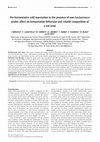Papers by Francesca Luziatelli
Frontiers in Plant Science, Feb 5, 2019
Bulletin of University of Agricultural Sciences and Veterinary Medicine Cluj-Napoca. Animal Science and Biotechnologies, Dec 14, 2008
Escherichia coli is considered a good host for the production of vanillin from phytochemicals, su... more Escherichia coli is considered a good host for the production of vanillin from phytochemicals, such as ferulic acid. A major drawback of this vanillin-producing system is the genetic instability of E. coli recombinant strains bearing genes encoding feruloyl-CoA synthetase and feruloyl-CoA hydratase/aldolase. In this work, the possibility to develop a more stable strain was explored by integrating into the E. coli chromosome the Pseudomonas fluorescens genes encoding these two enzymes. The resulting strain, named FR13, was more efficient in vanillin production than strains expressing the same genes from a low copy plasmid vector.

Comprehensive Reviews in Food Science and Food Safety, Jul 4, 2017
The gluten-free market currently offers a range of products which can be safely consumed by patie... more The gluten-free market currently offers a range of products which can be safely consumed by patients affected by celiac disease. Nevertheless, challenges for optimal formulation remain on the way in terms of appreciable texture, flavor, and adequate nutritional characteristics. Within that framework, legumes have recently attracted attention among scientists as structure-and texture-forming agents, as source of nutrients and bioactive compounds, and as a low-glycemic-index ingredient. This work aims at providing an updated and comprehensive overview of the advantages and disadvantages in the use of legumes in gluten-free breadmaking. It also shows how legumes can contribute to tackling the main technological, nutritional, and organoleptic challenges. From this critical analysis, it emerged that viscoelastic properties of gluten-free bread batter can be enhanced by the use of carob germ, chickpea, lupin, and soybean. Gluten-free bread organoleptic acceptability can be improved by incorporating leguminous flours, such as carob, chickpea, lupin, and soybean. Moreover, a better nutritional quality of gluten-free bread can be obtained by the addition of chickpea and soybean. Gaps and needs in the use of legumes in gluten-free breadmaking emerged and were gathered together to have a sound basis for future studies. The technological and nutritional potential of sourdough should be more extensively exploited. Moreover, in vitro and in vivo studies should be prompted to understand the health benefits of bread formulated with legumes. A holistic approach, interfacing food science, nutrition, and health might help to have, on the market, products with improved sensory properties and nutritional profile.

Frontiers in Microbiology, Mar 8, 2023
Introduction: The fermentative production of auxin/indole 3-acetate (IAA) using selected Pantoea ... more Introduction: The fermentative production of auxin/indole 3-acetate (IAA) using selected Pantoea agglomerans strains can be a promising approach to developing novel plant biostimulants for agriculture use. Methods: By integrating metabolomics and fermentation technologies, this study aimed to define the optimal culture conditions to obtain auxin/IAA-enriched plant postbiotics using P. agglomerans strain C1. Metabolomics analysis allowed us to demonstrate that the production of a selected. Results and discussion: Array of compounds with plant growth-promoting-(IAA and hypoxanthine) and biocontrol activity (NS-5, cyclohexanone, homo-Larginine, methyl hexadecenoic acid, and indole-3-carbinol) can be stimulated by cultivating this strain on minimal saline medium amended with sucrose as a carbon source. We applied a three-level-two-factor central composite design (CCD) based response surface methodology (RSM) to explore the impact of the independent variables (rotation speed and medium liquid-to-flask volume ratio) on the production of IAA and IAA precursors. The ANOVA component of the CCD indicated that all the process-independent variables investigated significantly impacted the auxin/IAA production by P. agglomerans strain C1. The optimum values of variables were a rotation speed of 180 rpm and a medium liquid-to-flask volume ratio of 1:10. Using the CCD-RSM method, we obtained a maximum indole auxin production of 208.3 ± 0.4 mg IAA equ /L, which was a 40% increase compared to the growth conditions used in previous studies. Targeted metabolomics allowed us to demonstrate that the IAA product selectivity and the accumulation of the IAA precursor indole-3-pyruvic acid were significantly affected by the increase in the rotation speed and the aeration efficiency.

Australian Journal of Grape and Wine Research, Dec 13, 2017
Background and Aims: This study evaluated the impact of pre-fermentative cold maceration (PCM), i... more Background and Aims: This study evaluated the impact of pre-fermentative cold maceration (PCM), in the presence of two non-Saccharomyces yeasts, Metschnikowia pulcherrima MP 346 and Metschnikowia fructicola MF 98-3, and of a commercial pectic enzyme, on fermentation kinetics and on the volatile composition of a Sangiovese red wine. Methods and Results: Sangiovese grape must was inoculated with MP 346 or MF 98-3 or treated with a pectic enzyme preparation during PCM, at 5 C for 24 or 72 h. A Control wine was produced by a pure culture of Saccharomyces cerevisiae. Both non-Saccharomyces strains affected the initial yeast population dynamics and the persistence of S. cerevisiae at the end of malolactic fermentation. Irrespective of the duration of PCM, the inoculum of Metschnikowia strains did not influence the rate of sugar consumption or the kinetics of malolactic fermentation. The volatile composition of the final wines was evaluated with solid-phase extraction, followed by GC/MS. The concentration of some terpenes and C13-norisoprenoids, nerol, geraniol, 8-hydroxy-linalool (cis) and 3-oxo-α-ionol, and of some esters, isoamyl lactate and ethyl isoamyl succinate, was higher in wines inoculated with Metschnikowia strains than in the Control and wine treated with pectic enzyme. Conclusions: Metschnikowia yeast strains MP 346 and MF 98-3 affect wine volatile composition. Significance of the Study: This study shows for the first time that an inoculum of Metschnikowia strains MP 346 and MF 98-3 during PCM is effective in modulating the volatile composition of a Sangiovese red wine.
Journal of Biotechnology, Nov 1, 2010

Beverages, Nov 7, 2017
Consumers have recently shown a preference for natural food products and ingredients and within t... more Consumers have recently shown a preference for natural food products and ingredients and within that framework, their interest in consuming raw drinking milk has been highlighted, claiming nutritional, organoleptic and health benefits. However, a public debate has simultaneously emerged about the actual risks and benefits of direct human consumption of raw milk. This paper compares the microbiological, nutritional and sensory profile of raw and heat-treated milk, to evaluate the real risks and benefits of its consumption. In detail, it provides an updated overview of the main microbiological risks of raw milk consumption, especially related to the presence of pathogens and the main outputs of risk assessment models are reported. After introducing the key aspects of most commonly used milk heat-treatments, the paper also discusses the effects such technologies have on the microbiological, nutritional and sensory profile of milk. An insight into the scientific evidence behind the claimed protective effects of raw milk consumption in lactose-intolerant subjects and against the onset of asthma and allergy disorders in children is provided. The emergence of novel milk processing technologies, such as ohmic heating, microwave heating, high pressure processing, pulsed electric fields, ultrasound and microfiltration is also presented as an alternative to common thermal treatments.

Antioxidants, Dec 2, 2020
Reducing food loss and waste is among the efforts to relieve the pressure on natural resources an... more Reducing food loss and waste is among the efforts to relieve the pressure on natural resources and move towards more sustainable food systems. Alternative pathways of food waste management include valorization of by-products as a source of phenolic compounds for formulation of functional foods. Bakery products may act as an optimal carrier of phenolic compounds upon fortification. The aim of this paper is to present and discuss the effect that the inclusion of functional ingredients from agri-food waste can have on phenolic content and bioaccessibility in bakery products. To this aim, methods for the recovery of phenolic compounds from agri-food waste are presented, and fortification of bakery products by waste from fruits, vegetables, and seed crops is discussed. Bioaccessibility studies on fortified food products are considered to identify gaps and needs in developing sustainable healthy foods. Fruit and vegetable by-products are among the food wastes mostly valorized as functional ingredients in bakery product formulation. Agri-food waste inclusion level has shown to correlate positively with the increase in phenolic content and antioxidant capacity. Nevertheless, further studies are required to assess bioaccessibility and bioavailability of phenolic compounds in enriched food products to estimate the potential of agri-food waste in promoting human health and well-being.

Zenodo (CERN European Organization for Nuclear Research), Oct 18, 2019
The rising demand of bio-vanillin and the possibility to use microbial biotransformation to produ... more The rising demand of bio-vanillin and the possibility to use microbial biotransformation to produce this compound from agroindustrial byproducts are economically attractive. However, there are still several bottlenecks, including substrate and product toxicity, formation of undesired products and genetic stability of the recombinant strains, that impede an efficient use of recombinant Escherichia coli strains to make the whole process cost effective. To overcome these problems, we developed a new E. coli strain, named FR13, carrying the Pseudomonas genes encoding feruloyl-CoA synthetase and feruloyl-CoA hydratase/aldolase integrated into the chromosome and, using resting cells, we demonstrated that the vanillin yield and selectivity were strongly affected by the physiological state of the cells, the temperature used for the growth and the recovery of the biomass and the composition and pH of the bioconversion buffer. The substrate consumption rate and the vanillin yield increased using a sodium/potassium phosphate buffer at pH 9.0 as bioconversion medium. Optimization of the bioprocess variables, using response surface methodology, together with the use of a two-phase (solid-liquid) system for the controlled release of ferulic acid allowed us to increase the vanillin yield up to 28.10 ± 0.05 mM. These findings showed that recombinant plasmid-free E. coli strains are promising candidates for the production of vanillin at industrial scale and that a reduction of the cost of the bioconversion process requires approaches that minimize the toxicity of both ferulic acid and vanillin.
Fermentation, Jul 30, 2021
This article is an open access article distributed under the terms and conditions of the Creative... more This article is an open access article distributed under the terms and conditions of the Creative Commons Attribution (CC BY

Microbiology resource announcements, Oct 31, 2019
Pantoea agglomerans strain C1 has plant growth-promoting (PGP) traits and exhibits antimicrobial ... more Pantoea agglomerans strain C1 has plant growth-promoting (PGP) traits and exhibits antimicrobial activity. The genome comprises 4.8 Mb, 4,696 proteincoding sequences, and a GϩC content of 55.2%. T he genus Pantoea (family Enterobacteriaceae) comprises bacteria that can be isolated from a wide variety of environments and hosts, including soil, water, and plants (1-3). Distinctive strains of Pantoea are recognized as plant growth-promoting rhizobacteria (PGPR) and can potentially be used to develop new biofertilizers or biological control agents for sustainable agriculture (4). P. agglomerans strain C1 was isolated from the phyllosphere of Lactuca sativa L. (lettuce) plants treated with vegetal-derived protein hydrolysates (5). It has some interesting plant growth-promoting features, such as the ability to produce indole-3acetic acid (a plant hormone of the auxin class), and showed antagonistic activity against some phytopathogenic fungi and bacteria (6). The genomic DNA was extracted from cells grown overnight in Luria broth by using a PureLink genomic DNA minikit (Thermo Fisher Scientific, Italy), as reported elsewhere (6). The genomic library was prepared using a Nextera XT DNA library prep kit and Nextera XT index kit (Illumina, USA). The library fragment size distribution was checked using an Agilent 2100 Bioanalyzer (Agilent Technologies, Santa Clara, CA, USA), and DNA was quantified using a Qubit 2.0 fluorometer and the Qubit double-stranded DNA (dsDNA) high-sensitivity (HS) assay kit (Thermo Fisher Scientific). The whole-genome sequencing of strain C1 was performed at Bio-Fab Research S.r.l. (Rome, Italy) using the MiSeq platform (paired-end 2 ϫ 300 bp) with the MiSeq reagent kit v3 (Illumina). In total, 7,525,566 reads were obtained, achieving about 150-fold genomic coverage. Read quality was checked using FastQC 0.11.5 (7), whereas adapter and low-quality sequences were trimmed using Trimmomatic 0.39 (8). Default parameters were used for all software unless otherwise noted. The resulting reads were assembled into contigs using the A5-MiSeq assembly pipeline (version 20160826) (9), and the quality of the assembly was assessed using QUAST version 5.0.2 (10). The Mauve tool (11) was used to align and order the assembled contigs using Pantoea agglomerans strain C410P1 (GenBank accession number CP016889) as a reference. The genome assembly produced 22 contigs, with an N 50 value of 645,999 bp, and the largest contig was 2,247,784 bp. The genome of P. agglomerans C1 was 4,846,925 bp, with a GϩC content of 55.2%, which falls within the genome size (4.5 to 6.3 Mb) and GϩC content (52% to 55%) of other strains belonging to the same genus. The RASTtk (12, 13) and PATRIC (14) programs were used for genome annotation, with default parameters and using the Enterobacteriales data set as a reference. No plasmid was detected in the genome by using Plasmid Finder (15). P. agglomerans C1 has 4,696 protein-encoding genes (PEGs), as predicted using GLIMMER 3 (16), of which 3,784 (81%) have a predicted function assigned using the GenDB annotation pipeline (17),

Acta horticulturae, Nov 1, 2016
There is growing evidence demonstrating the potential of various organic substances, including pl... more There is growing evidence demonstrating the potential of various organic substances, including plant extracts and plant derived-protein hydrolysates, to increase crop productivity and ameliorate crop tolerance to abiotic stresses, such as drought and salinity. In contrast to the large amount of data on the impact of these substances on crop productivity, little information is available on their effect on the biodiversity of plant-associated bacteria. The aim of this study was to evaluate the effect of foliar applications of a protein hydrolysate-based biostimulant ('Trainer'), a fertilizer containing micronutrients mixed with plant extracts ('Auxym'), and a fertilizer containing copper complexed with peptides and amino acids ('Scudo') on the structure of phyllosphere bacterial community in lettuce. Data obtained using culture-independent (Terminal Restriction Fragment Length Polymorphism) and culture-dependent approaches indicated that biostimulant/fertilizers altered the composition of the microbial population and stimulated the growth of specific bacteria taxa exhibiting potential plant growth-promoting properties (indole acetic production and phosphate solubilization) and/or biocontrol activity against Fusarium oxysporum and Erwinia amylovora.

Microorganisms, Jan 22, 2020
Distinctive strains of Pantoea are used as soil inoculants for their ability to promote plant gro... more Distinctive strains of Pantoea are used as soil inoculants for their ability to promote plant growth. Pantoea agglomerans strain C1, previously isolated from the phyllosphere of lettuce, can produce indole-3-acetic acid (IAA), solubilize phosphate, and inhibit plant pathogens, such as Erwinia amylovora. In this paper, the complete genome sequence of strain C1 is reported. In addition, experimental evidence is provided on how the strain tolerates arsenate As (V) up to 100 mM, and on how secreted metabolites like IAA and siderophores act as biostimulants in tomato cuttings. The strain has a circular chromosome and two prophages for a total genome of 4,846,925-bp, with a DNA G+C content of 55.2%. Genes related to plant growth promotion and biocontrol activity, such as those associated with IAA and spermidine synthesis, solubilization of inorganic phosphate, acquisition of ferrous iron, and production of volatile organic compounds, siderophores and GABA, were found in the genome of strain C1. Genome analysis also provided better understanding of the mechanisms underlying strain resistance to multiple toxic heavy metals and transmission of these genes by horizontal gene transfer. Findings suggested that strain C1 exhibits high biotechnological potential as plant growth-promoting bacterium in heavy metal polluted soils.

Chemical Papers, Jan 10, 2023
Differential scanning calorimetry (DSC) was used as an efficient and rapid tool in studying the c... more Differential scanning calorimetry (DSC) was used as an efficient and rapid tool in studying the conformational transitions between the folded and unfolded structures of cellulolytic enzymes. The thermal properties of two crude hydrolytic enzyme cocktails containing extracellular cellulases from Trichoderma longibrachiatum DIBAF-10 were analyzed and compared with three commercial cellulase preparations. Differences in the thermal behavior of fungal cellulases in the liquid phase, freeze-dried state, liquid formulations in sodium citrate buffer (pH 4.8), and contact with cellulose, carboxymethyl cellulose, and cellobiose were evaluated. DSC profiles of cellulases from the DIBAF-10 strain provided important thermodynamic information about the thermal stability of the included proteins. Crude enzyme cocktails underwent a reproducible and irreversible exothermic aggregation phenomenon at 52.45 ± 0.90 °C like commercial β-glucosidase. Freeze-dried and resuspended in a sodium citrate buffer, cellulases from T. longibrachiatum showed an endothermic peak dependent on buffer and enzyme concentration. In the enzyme-substrates systems, a shift of the same peak was recorded for all substrates tested. The thermal analysis of freeze-dried cellulase samples in the range of 20-150 °C gave information on the denaturation process. In conclusion, we demonstrated that DSC is a cost-effective tool for obtaining "conformational fingerprinting" of crude fungal cellulase preparations.
Bulletin of University of Agricultural Sciences and Veterinary Medicine Cluj-Napoca. Animal Science and Biotechnologies, Dec 15, 2008
Using an integrative vector, Pseudomonas genes encoding feruloyl-CoA synthetase and feruloyl-CoA ... more Using an integrative vector, Pseudomonas genes encoding feruloyl-CoA synthetase and feruloyl-CoA hydratase/aldolase were integrated into the lacZ gene site of Escherichia coli. The resulting strain was very stable and more efficient in vanillin production than strains expressing ferulic catabolic genes from a low-copy vector. Optimization of culture conditions and bioconversion parameters, together with the reuse of the biomass, leaded to a final yield of 6.6 Kg of vanillin per Kg of biomass, which is the maximum vanillin yield value reported using resting cells of E. coli.

Zenodo (CERN European Organization for Nuclear Research), May 27, 2019
Fermented foods have long been produced according to knowledge passed down from generation to gen... more Fermented foods have long been produced according to knowledge passed down from generation to generation and with no understanding of the potential role of the microorganism(s) involved in the process. However, the scientific and technological revolution in Western countries made fermentation turn from a household to a controlled process suitable for industrial scale production systems intended for the mass marketplace. The aim of this paper is to provide an up-to-date review of the latest studies which investigated the health-promoting components forming upon fermentation of the main food matrices, in order to contribute to understanding their important role in healthy diets and relevance in national dietary recommendations worldwide. Formation of antioxidant, bioactive, anti-hypertensive, anti-diabetic, and FODMAP-reducing components in fermented foods are mainly presented and discussed. Fermentation was found to increase antioxidant activity of milks, cereals, fruit and vegetables, meat and fish. Anti-hypertensive peptides are detected in fermented milk and cereals. Changes in vitamin content are mainly observed in fermented milk and fruits. Fermented milk and fruit juice were found to have probiotic activity. Other effects such as anti-diabetic properties, FODMAP reduction, and changes in fatty acid profile are peculiar of specific food categories.
25° Congresso Nazionale della Società Italiana di Microbiologia Generale e Biotecnologie Microbiche (SIMGBM),, 2006

Frontiers in Microbiology
IntroductionThe fermentative production of auxin/indole 3-acetate (IAA) using selected Pantoea ag... more IntroductionThe fermentative production of auxin/indole 3-acetate (IAA) using selected Pantoea agglomerans strains can be a promising approach to developing novel plant biostimulants for agriculture use.MethodsBy integrating metabolomics and fermentation technologies, this study aimed to define the optimal culture conditions to obtain auxin/IAA-enriched plant postbiotics using P. agglomerans strain C1. Metabolomics analysis allowed us to demonstrate that the production of a selected.Results and discussion:Array of compounds with plant growth-promoting- (IAA and hypoxanthine) and biocontrol activity (NS-5, cyclohexanone, homo-L-arginine, methyl hexadecenoic acid, and indole-3-carbinol) can be stimulated by cultivating this strain on minimal saline medium amended with sucrose as a carbon source. We applied a three-level-two-factor central composite design (CCD) based response surface methodology (RSM) to explore the impact of the independent variables (rotation speed and medium liquid...











Uploads
Papers by Francesca Luziatelli